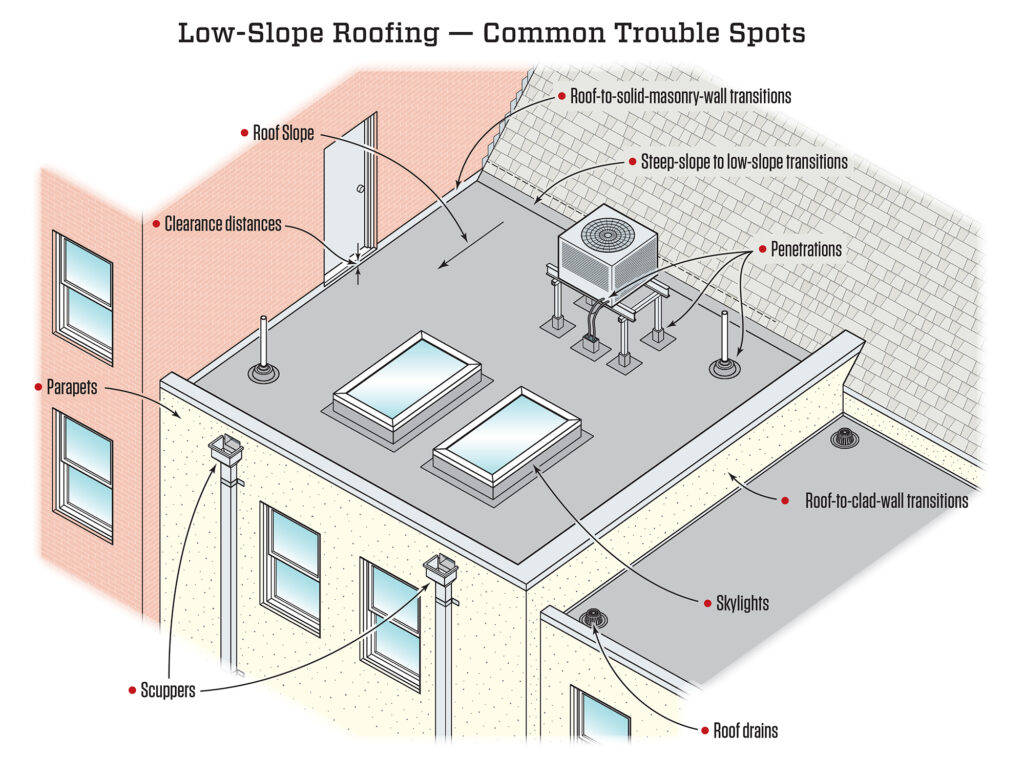When most people hear “flat roof,” they picture a rooftop that’s perfectly level—like a tabletop stretching from wall to wall. But in the roofing industry, “flat” is a bit of a misnomer. In reality, flat roofs are carefully engineered with a subtle slope, and this small detail makes a huge difference in the performance and longevity of your roof. At Brown’s Roofing, we believe that understanding the “why” and “how” behind this design can help property owners make smarter decisions about their buildings.
Why Flat Roofs Can’t Be Truly Flat
The main reason flat roofs aren’t actually flat comes down to one word: drainage. Water is the number one enemy of any roofing system. If water is allowed to pool, it can lead to a host of problems, including:
- Leaks and Water Intrusion: Even the best roofing membranes can eventually fail if water is allowed to sit for long periods. Over time, standing water finds its way through seams, fasteners, or tiny punctures.
- Structural Stress: Water is heavy—just one inch of standing water weighs about 5 pounds per square foot. Over time, this extra weight can cause the roof deck to sag, which only makes ponding worse.
- Accelerated Deterioration: Constant moisture can break down roofing materials, adhesives, and insulation, shortening the lifespan of your roof.
- Mold, Mildew, and Algae: Persistent dampness creates the perfect environment for biological growth, which can damage materials and affect indoor air quality.

The Subtle Slope: How Much Is Enough?
Building codes and best practices dictate that a “flat” roof should have a minimum slope—usually at least 1/4 inch per foot (2%). This means that for every 12 horizontal inches, the roof should drop at least 1/4 inch. In some cases, especially in areas with heavy rainfall or snow, a steeper slope may be recommended.
This slope is just enough to encourage water to flow toward drains, scuppers, or gutters, but not so steep that it affects the usability of the roof for HVAC units, solar panels, or foot traffic.
How Is the Slope Achieved?
There are several ways to create the necessary slope on a flat roof:
- Tapered Insulation Systems: One of the most common methods, especially in commercial roofing, is to use insulation boards that are manufactured with a built-in slope. These boards are installed on top of the roof deck and beneath the waterproof membrane, creating a gentle incline toward drainage points.
- Sloped Structural Decking: In new construction, the roof deck itself can be built with a slight pitch. This is often done with steel or wood joists that are set at an angle.
- Crickets and Saddles: These are small, raised sections built into the roof to divert water around obstacles (like HVAC units or skylights) and toward drains.
- Tapered Lightweight Concrete: In some cases, a lightweight concrete fill is poured and shaped to create the desired slope before the roofing membrane is installed.
Drainage Solutions: Getting Water Off the Roof
A well-designed flat roof doesn’t just rely on slope—it also needs an effective drainage system. The most common options include:
- Internal Drains: These are placed at low points in the roof and connect to pipes that carry water away through the building’s plumbing system. They’re ideal for large commercial roofs.
- Scuppers: Openings in the parapet walls that allow water to drain off the edge of the roof into downspouts.
- Gutters and Downspouts: These collect water from the roof edge and direct it safely away from the building’s foundation.
Regular maintenance is crucial—drains and gutters must be kept clear of debris to prevent blockages and ponding.

Common Misconceptions About Flat Roofs
Many property owners worry that flat roofs are more prone to leaks or require more maintenance than pitched roofs. While it’s true that flat roofs demand careful design and regular inspection, a properly installed and maintained flat roof can last just as long as a sloped one. The key is ensuring that the slope and drainage systems are up to code and functioning as intended.
Brown’s Roofing: Your Flat Roof Experts
At Brown’s Roofing, we specialize in the design, installation, and maintenance of flat roofing systems for both commercial and residential properties. Our team understands the science behind flat roof construction and uses the latest materials and techniques to ensure your roof sheds water efficiently and stands the test of time.
If you’re planning a new flat roof or need help with an existing one, contact Brown’s Roofing today. We’ll assess your roof’s slope, drainage, and overall condition, and recommend solutions tailored to your building’s needs. Remember: when it comes to flat roofs, a little slope goes a long way!
